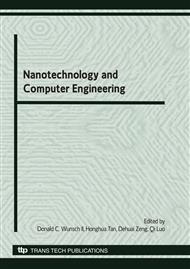[1]
A. Colorni, M. Dorigo and V. Mariiezzo. Distributed Optimization by Ant Colonies, in: Proc. Eearop. Conf. Artificial Life, ed. F. Varela and P. Bourgine, (Elsevier, Amsterdam, 1991).
Google Scholar
[2]
M. Dorigo and L.M. Gambardella. Ant Colony System: A Cooperative Learning Approach to the Traveling Salesman Problem. IEEE Transactions on Evolutionary Computation, 1(1): 53-66, (1997).
DOI: 10.1109/4235.585892
Google Scholar
[3]
T. Stützle and H.H. Hoos. The MAX-MIN Ant System and Local Search for the Traveling Salesman Problem. In T. Saeck, Z. Michalewicz, and N. Yao, editors, Proceedings of the IEEE International Conference on Evolution anj Computation (ICEC'97'), pages 309-314, (1997).
DOI: 10.1109/icec.1997.592327
Google Scholar
[4]
L.M. Gambardella, M. Dorigo. Solving Symmetric and Asymmetric TSPs by Ant Colonies, Proceedings of the IEEE Conference on Evolutionary Computation, ICEC96, IEEE Press, 1996, 622-627.
DOI: 10.1109/icec.1996.542672
Google Scholar
[5]
A. C. Zecchin, H. R. Maier, A. R. Simpson, M. Leonard, & J. B. Nixon. Ant colony optimization applied to water distribution system design: comparative study of five algorithms. Journal of Water Resources Planning and Management, 133(1), 87-92, (2007).
DOI: 10.1061/(asce)0733-9496(2007)133:1(87)
Google Scholar
[6]
Y. Li, & A. B. Chan Hilton. Optimal groundwater monitoring design using an ant colony optimization paradigm. Environmental Modelling and Software, 22(1), 110-116, (2007).
DOI: 10.1016/j.envsoft.2006.05.023
Google Scholar
[7]
Y. Aksoy, & A. Derbez. Software survey: supply chain management. OR/MS Today, 30(3), 1-13, (2003).
Google Scholar
[8]
B. Bullnheimer, R. F. Hartl, & C. Strauss. Applying the Ant System to the vehicle routing problem. In S. Voss., S. Martello, I. H. Osman, & C. Roucairol (Eds. ), Meta-heuristics: Advances and trends in local search paradigms for optimization (pp. 109C120), 1998. Boston: Kluwer.
DOI: 10.1007/978-1-4615-5775-3_20
Google Scholar
[9]
L.M. Gambardella, E. Taillard, and G. Agazzi. MACS-VRPTW: a multiple ant colony system for vehicle routing problems with time windows. in New ideas in optimization. D. Corne et al. editors. Pages 63-76, (1999).
Google Scholar
[10]
A.E. Rizzoli, R. Montemanni, E. Lucibello, & L.M. Gambardella. Ant colony optimization for real-world vehicle routing problems. From theory to applications. Swarm Intelligence, 1(2): 135-151, (2007).
DOI: 10.1007/s11721-007-0005-x
Google Scholar
[11]
D. Angus, & C. Woodward. Multiple objective ant colony optimization. Swarm Intelligence 3(1) 69-85, (2009).
DOI: 10.1007/s11721-008-0022-4
Google Scholar
[12]
R. Montemanni, L. Gambardella, A. Rizzoli, and A. Donati. A new algorithm for a dynamic vehicle routing problem based on ant colony system. In Second International Workshop on Freight Transportation and Logistics, (2003).
DOI: 10.1007/s10878-005-4922-6
Google Scholar
[13]
X. Hu, J. Zhang & Y. Li. Flexible protein folding by ant colony optimization. In: Computational Intelligence in Biomedicine and Bioinformatics: Current Trends and Applications. Springer-Verlag, New York, pp.317-336, (2008).
DOI: 10.1007/978-3-540-70778-3_13
Google Scholar
[14]
M. Dorigo, V. Maniezzo and A. Colorni. Ant System: Optimization by a Colony of Cooperating Agents, IEEE Trans. Sys., Man, Cybernetics 26(1996)29.
DOI: 10.1109/3477.484436
Google Scholar
[15]
L. Paquete and T. Stützle. A study of stochastic local search algorithms for the biobjective QAP with correlated flow matrices (2004).
DOI: 10.1016/j.ejor.2004.08.024
Google Scholar
[16]
B. Bullnheimer, R. F. Hartl, & C. Strauss. An improved Ant System algorithm for the vehicle routing problem. (Tech. Rep. POM-10/97). Vienna, Austria: University of Vienna, Institute of Management Science, (1997).
Google Scholar
[17]
Gendreau, M., Hertz, A. and Laporte, G.: A tabu search heuristic for the vehicle routing problem. Management Science 40: 1276-1290, (1994).
DOI: 10.1287/mnsc.40.10.1276
Google Scholar
[18]
L.M. Gambardella, E. Taillard, and G. Agazzi. MACS-VRPTW: a multiple ant colony system for vehicle routing problems with time windows. In New ideas in optimization. D. Corne et al. editors. Pages 63-76, (1999).
Google Scholar
[19]
N. Christofides, A. Mingozzi and P. Toth: The vehicle routing problem. Combinatorial Optimization. Wiley, Chicester, (1979).
Google Scholar


